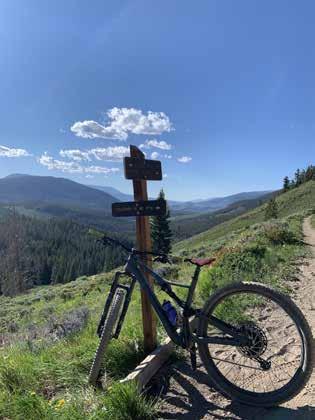
3 minute read
BACKCOUNTRY
mountaintownbreckenridge.com | ISSUE 2 2021 35

Advertisement
Staying in the Saddle
BY HALEY LITTLETON
The third time I ever rode a mountain bike, it ended with a tear-stained sleeve and my slumped body on the side of the trail quietly kicking the dirt as I drummed up the energy to finish the last few miles. I didn’t own a chamois yet, and every ounce of me resisted gingerly sitting onto the saddle again. My companions were far ahead, forgetting that, at this point in time, my feet were most comfortable pounding the dirt in a pair of Hokas, not on elevated platforms several inches off the ground.
I can’t say that I was being nice to myself at that moment. A sense of shame flooded my body, and I was practicing my speech as I caught up to the group to explain away the tears and embarrassment of my struggle.
“Oh, I was focusing on my form and took a spill. That’s why it took so long.”
“Maybe something is wrong with the bike?”
“I’m in trail running shape, just not mountain biking shape.”
I needed everyone to still believe that facade that I was perfect and never struggled. In the Spring of 2018, I had not yet learned the craft of starting over, which I have done again and again since then. Besides, I was terrified to hit the ground, white-knuckling, bracing, and steering my body away from it at all costs. I would hit it soon enough.
But I’m not a quitter, so I immediately bought a bike when I got home. Thank god for my stubbornness. I inched my way forward that first season and the second by pure determination. I was often more concerned with shouldering the mantle of the “mountain biker” identity than I was with my satisfaction from biking. I wondered what mileage I had to hit to become a “mountain biker.” I wondered what speed I needed to descend at to be crowned a “mountain biker.” Did I have to have a certain kit or gear? Did I need to have the best Strava segments?
Turns out, all that was required to become a “mountain biker” was to ride my bike.
In the fall of 2019, I hit the ground, metaphorically, and entered one of the darkest periods of my adult mental health. Surprisingly, my mountain bike became my solace, a place where I could gain a sense of stability and tether my body to the gritty “here and now.”
What I once found demoralizing became one of my reason to get up in the morning. Unlike that first day splayed out on the side of the trail, I found that I could cry and pedal at the same time, and, often, I felt better afterward. I found that those long, solitary miles of singletrack were the best places to unravel all that I thought I knew, pedal stroke after stroke.
External motivators and validation never quite get us through that last mile. They rarely push us up the last switchback of Wheeler Pass. They dissolve biking plans when partners bail at the last minute. They may bolster the pace and mileage for Strava but they’re never quite satisfied by the kudos.
Claiming mountain biking for myself and my personal fulfillment keeps me in the saddle. The feeling of pushing past my own perceived limitations on the dirt translates into blowing past low expectations in other arenas. And, magically, shame becomes celebration.
Now, I laugh much more on my bike. I even let a st ray giggle out here and there. I might annoy my riding partners at times with my incessant positivity but it’s always paired with the drive to progress.
It has shifted from “Sorry, I’m so slow.” to “Wow! That took me a bit, but I’ve never cleaned that climb before, and I’m so proud!”
From “ I don’t think I can ride that. I’ll try it next time” to “Do you mind if we stay for a few minutes so I can session this rock?”
Progression and healing are like a good singletrack - it curves and loops and bends back upon itself at times but it always gets you where you need to be. You just have to trust the turn.










